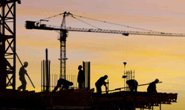Steel Markets

Nonresidential Construction Spending Lags Behind Home Building
Written by Sandy Williams
November 2, 2020
Residential construction spending continues to lead nonresidential by a wide gap, said the Associated General Contractors of America. Total construction spending in September increased 0.3 percent from August to a seasonally adjusted annual rate of $1.41 trillion.
Private and public nonresidential spending fell 1.6 percent from August and 4.4 percent from a year ago. In comparison, private residential spending increased 2.8 percent from the prior month and soared 9.9 percent from September 2019.
“The September spending report shows the gulf between housing and nonresidential markets is growing steadily wider,” said Ken Simonson, the association’s chief economist. “In our October survey, 75 percent of respondents reported a postponed or cancelled project, up from 60 percent in August and 32 percent in June.”
Public construction spending fell for the fourth month in a row, dipping 1.7 percent in September. Highway and street construction fell 5.4 percent while transportation construction spending dipped 0.3 percent. Spending in the education sector gained 2.0 percent for the month.
Private nonresidential construction spending decreased in nine of 11 categories with an overall decline of 1.5 percent from August to September. Power construction fell 2.2 percent, commercial construction 2.2 percent and manufacturing construction 2.1 percent. Construction of data centers continues to be a bright spot.
In the residential sector, single-family homebuilding soared 5.7 percent and multi-family construction climbed 1.2 percent. Spending for home improvement dipped 0.4 percent after seeing strong demand in the past few months.
“The pandemic is suppressing demand for new office buildings, hotels and shopping centers even while it inspires many people to build bigger homes,” said Stephen E. Sandherr, the AGC’s chief executive officer. “Without new federal investments in infrastructure and other needed relief measures, commercial firms will have a hard time retaining staff or investing in new equipment and supplies.”

Sandy Williams
Read more from Sandy WilliamsLatest in Steel Markets

CMC looks beyond Arizona micro-mill woes to long-term viability of construction mart
Despite the economic and geopolitical upheaval of the last five years, CMC President and CEO Peter Matt points out that the construction market has been an essential element of the way forward.

US importers face stricter rules under revamped S232 tariffs
“CBP expects full compliance from the trade community for accurate reporting and payment of the additional duties. CBP will take enforcement action on non-compliance," the agency said in a March 7 bulletin.

Steel exports rebound in January
US steel exports recovered to a five-month high in January after having fallen to a two-year low in December. This growth follows four consecutive months of declining exports.

Construction spending drops marginally in January
Construction spending edged down slightly in January, slipping for the first time in four months. The US Census Bureau estimated spending at a seasonally adjusted annual rate of $2,196 billion in January, down 0.2% from December’s downward revised rate. The January figure is 3.3% higher than a year ago. January’s result, despite the slight erosion, […]

HVAC equipment shipments slow in December but strong annually
Shipments of heating and cooling equipment in the US fell to an 11-month low in December, according to the latest data released by the Air-Conditioning, Heating, and Refrigeration Institute (AHRI).
